
NGC 4725 is an intermediate barred spiral galaxy with a prominent ring structure, located in the northern constellation of Coma Berenices near the north galactic pole. It was discovered by German-born British astronomer William Herschel on April 6, 1785. The galaxy lies at a distance of approximately 40 megalight-years from the Milky Way. NGC 4725 is the brightest member of the Coma I Group of the Coma-Sculptor Cloud, although it is relatively isolated from the other members of this group. This galaxy is strongly disturbed and is interacting with neighboring spiral galaxy NGC 4747, with its spiral arms showing indications of warping. The pair have an angular separation of 24′, which corresponds to a projected linear separation of 370 kly. A tidal plume extends from NGC 4747 toward NGC 4725.

NGC 2787 is a barred lenticular galaxy approximately 24 million light-years away in the northern constellation of Ursa Major. It was discovered on December 3, 1788 by German-born astronomer William Herschel. J. L. E. Dreyer described it as, "bright, pretty large, a little extended 90°, much brighter middle, mottled but not resolved, very small (faint) star involved to the southeast". The visible galaxy has an angular size of 2.5 × 1.5 arcminutes or 3.24 × 1.81 arcminutes and an apparent visual magnitude of 11.8.
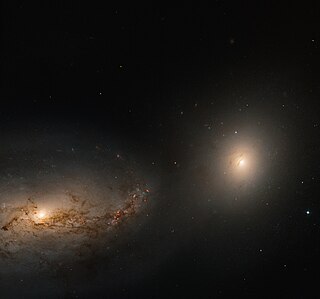
NGC 3227 is an intermediate spiral galaxy that is interacting with the dwarf elliptical galaxy NGC 3226. The two galaxies are one of several examples of a spiral with a dwarf elliptical companion that are listed in the Atlas of Peculiar Galaxies. Both galaxies may be found in the constellation Leo. It is a member of the NGC 3227 Group of galaxies, which is a member of the Leo II Groups, a series of galaxies and galaxy clusters strung out from the right edge of the Virgo Supercluster.

NGC 514 is a low-luminosity, intermediate spiral galaxy in the equatorial constellation of Pisces, located at a distance of approximately 83 million light-years from the Milky Way. It was discovered on 16 October 1784 by astronomer William Herschel. The general form of the galaxy is specified by its morphological classification of SAB(rs)c, which indicates it has a weak bar system at the core (SAB), an incomplete ring formation around the bar (rs), and somewhat loosely-wound spiral arms (c). This galaxy has an H II nucleus with an extended region that displays weak emission lines in the optical range, but not in the near infrared. The suspected supermassive black hole at the core has an estimated mass of 3.2×106 M☉.

NGC 5548 is a Type I Seyfert galaxy with a bright, active nucleus. This activity is caused by matter flowing onto a 65 million solar mass (M☉) supermassive black hole at the core. Morphologically, this is an unbarred lenticular galaxy with tightly-wound spiral arms, while shell and tidal tail features suggest that it has undergone a cosmologically-recent merger or interaction event. NGC 5548 is approximately 245 million light years away and appears in the constellation Boötes. The apparent visual magnitude of NGC 5548 is approximately 13.3 in the V band.

NGC 4194, the Medusa merger, is a galaxy merger in the constellation Ursa Major about 128 million light-years (39.1 Mpc) away. It was discovered on April 2, 1791 by German-British astronomer William Herschel. Due to its disturbed appearance, it is object 160 in Halton Arp's 1966 Atlas of Peculiar Galaxies.

NGC 1566, sometimes known as the Spanish Dancer, is an intermediate spiral galaxy in the constellation Dorado, positioned about 3.5° to the south of the star Gamma Doradus. It was discovered on May 28, 1826 by Scottish astronomer James Dunlop. At 10th magnitude, it requires a telescope to view. The distance to this galaxy remains elusive, with measurements ranging from 6 Mpc up to 21 Mpc.

NGC 4639 is a barred spiral galaxy located in the equatorial constellation of Virgo. It was discovered by German-born astronomer William Herschel on April 12, 1784. John L. E. Dreyer described it as "pretty bright, small, extended, mottled but not resolved, 12th magnitude star 1 arcmin to southeast". This is a relatively nearby galaxy, lying approximately 72 million light-years away from the Milky Way. It is a companion to NGC 4654, and the two appear to have interacted roughly 500 million years ago. NGC 4639 is a member of the Virgo Cluster.

NGC 4710 is an edge-on lenticular galaxy in the northern constellation of Coma Berenices. It was discovered on March 21, 1784 by German-British astronomer William Herschel. This galaxy has a B-band visual magnitude of 11.60 and an angular size of 3.0′ × 0.8′. It is located at a distance of 54.5 ± 3.6 million light-years (16.7 ± 1.1 Mpc) from the Milky Way, and is receding with a heliocentric radial velocity of 1,129 km/s. This is a member of the Virgo Cluster, with a projected offset of ~6° from the cluster center and a cluster crossing time of around two billion years.
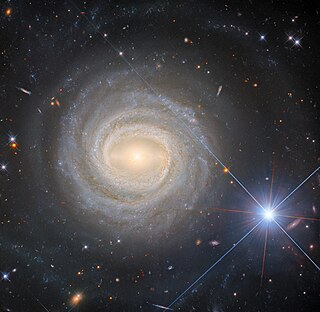
NGC 3783 is a barred spiral galaxy located about 135 million light years away in the constellation Centaurus. It is inclined by an angle of 23° to the line of sight from the Earth along a position angle of about 163°. The morphological classification of SBa indicates a bar structure across the center (B) and tightly-wound spiral arms (a). Although not shown by this classification, observers note the galaxy has a luminous inner ring surrounding the bar structure. The bright compact nucleus is active and categorized as a Seyfert 1 type. This nucleus is a strong source of X-ray emission and undergoes variations in emission across the electromagnetic spectrum.
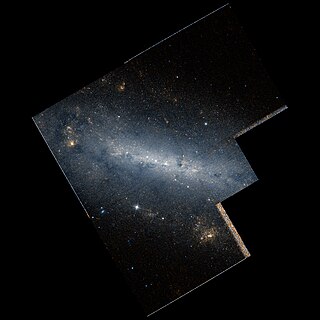
NGC 672 is a spiral galaxy in the northern constellation of Triangulum, positioned around 2° to the southwest of the star Alpha Trianguli. The original object designated NGC 672 was discovered by the German-born astronomer William Herschel on 26 October 1786, but this was later cataloged as NGC 614. The object now identified as NGC 672 was discovered by John Herschel on 11 November 1827.

NGC 4203 is the New General Catalogue identifier for a lenticular galaxy in the northern constellation of Coma Berenices. It was discovered on March 20, 1787 by English astronomer William Herschel, and is situated 5.5° to the northwest of the 4th magnitude star Gamma Comae Berenices and can be viewed with a small telescope. The morphological classification of NGC 4203 is SAB0−, indicating that it has a lenticular form with tightly wound spiral arms and a weak bar structure at the nucleus.

NGC 4424 is a spiral galaxy located in the equatorial constellation of Virgo. It was discovered February 27, 1865 by German astronomer Heinrich Louis d'Arrest. This galaxy is located at a distance of 13.5 million light years and is receding with a heliocentric radial velocity of 442 km/s. It has a morphological class of SB(s)a, which normally indicates a spiral galaxy with a barred structure (SB), no inner ring feature (s), and tightly-wound spiral arms (a). The galactic plane is inclined at an angle of 62° to the line of sight from the Earth. It is a likely member of the Virgo Cluster of galaxies.

NGC 708 is an elliptical galaxy located 240 million light-years away in the constellation Andromeda and was discovered by astronomer William Herschel on September 21, 1786. It is classified as a cD galaxy and is the brightest member of Abell 262. NGC 708 is a weak FR I radio galaxy and is also classified as a type 2 Seyfert galaxy.

NGC 612 is a lenticular galaxy in the constellation of Sculptor located approximately 388 million light-years from Earth. It is a type II Seyfert galaxy and thus has an active galactic nucleus. NGC 612 has been identified as an extremely rare example of a non-elliptical radio galaxy, hosting one of the nearest powerful FR-II radio sources.
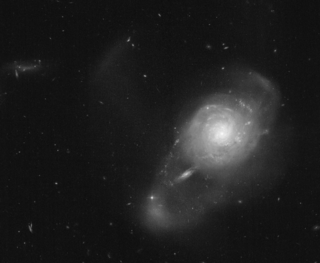
NGC 7679 is a lenticular galaxy with a peculiar morphology in the constellation Pisces. It is located at a distance of about 200 million light years from Earth, which, given its apparent dimensions, means that NGC 7679 is about 60,000 light years across. It was discovered by Heinrich d'Arrest on September 23, 1864. The total infrared luminosity is 1011.05 L☉, and thus it is categorised as a luminous infrared galaxy. NGC 7679 is both a starburst galaxy and a Seyfert galaxy.

NGC 4324 is a lenticular galaxy located about 85 million light-years away in the constellation Virgo. It was discovered by astronomer Heinrich d'Arrest on March 4, 1862. NGC 4324 has a stellar mass of 5.62 × 1010M☉, and a baryonic mass of 5.88 × 1010M☉. The galaxy's total mass is around 5.25 × 1011M☉. NGC 4324 is notable for having a ring of star formation surrounding its nucleus. It was considered a member of the Virgo II Groups until 1999, when its distance was recalculated and it was placed in the Virgo W Group.
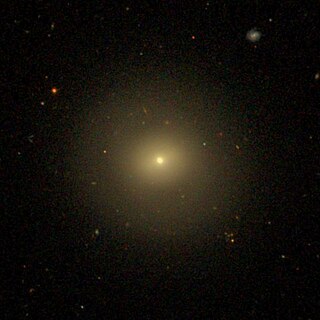
NGC 3599 is a lenticular galaxy located in the constellation Leo. It was discovered by William Herschel on March 14, 1784. The galaxy is located at a distance of 67 million light-years (20.4 Mpc) from the Sun. NGC 3599 is a member of the Leo II group of galaxies in the Virgocentric flow.

NGC 2617 is a Seyfert galaxy in the equatorial constellation of Hydra. It was discovered on February 12, 1885, by French astronomer Édouard Stephan. In 1888, Danish astronomer J. L. E. Dreyer described it as "extremely faint, very small, 2 very faint stars involved". It is located at an estimated distance of 202 million light years. In the infrared, the galaxy has an angular size of 0.693 by 0.652 arcminutes.

NGC 3786 is an intermediate spiral galaxy located 107.5 million light-years away in the northern constellation of Ursa Major. It was discovered by English astronomer John Herschel on April 10, 1831. This object appears to form a close pair with its peculiar neighbor to the north, NGC 3788. They show some indications of interaction, such as minor distortion of the disk or tidal features.




















